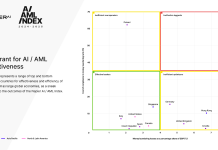The constant evolution of the financial landscape has placed anti-money laundering (AML) and counter-financing of terrorism (CFT) measures at the forefront of combating financial crime. AML/CFT platforms, which offer the promise of robust deterrents to financial crime, have emerged as vital tools in this battle. However, the integration of vast amounts of data into these platforms presents numerous challenges.
RegTech platform Flagright recently explained how companies can overcome data integration challenges with AML platforms.
Data, often deemed the lifeblood of modern organisations, is crucial to AML/CFT practices. The ability to collect, process, and analyse copious amounts of transactional data forms the backbone of these platforms. The challenge, however, lies in the complexity of integrating data from various sources into an AML platform whilst ensuring data accuracy, consistency, and completeness.
Data integration is not merely a technical hurdle. It represents a comprehensive challenge that spans data quality, data security, data format compatibility, data volume, data privacy compliance, real-time integration, integration complexity, and regulatory compliance. Overcoming these challenges requires innovative solutions that address not only the technical difficulties but also adhere to privacy laws and AML regulations.
The role of financial institutions in the global economic network is multi-faceted and intricate, making them an attractive target for illicit activities such as money laundering and financing of terrorism. In this digital age, the need for effective AML/CFT practices is more crucial than ever. These practices form a barrier against bad actors attempting to exploit the financial system for unlawful purposes.
Underpinning successful AML/CFT practices is the ability to monitor and analyse financial transactions accurately and in real-time. AML platforms, employing sophisticated algorithms to detect suspicious activities, depend heavily on the quality and accuracy of their data. Hence, efficient data integration is paramount to their success.
Effective data integration facilitates risk assessment, real-time monitoring of transactions, regulatory reporting, and customer due diligence (CDD) and know your customer (KYC) processes. However, if the challenges associated with data integration are not effectively addressed, it can lead to significant drawbacks including gaps in risk assessment, delayed detection of suspicious activities, non-compliance with reporting requirements, and incomplete customer profiles. All of these can undermine the fight against financial crime.
The challenges of data integration in AML/CFT compliance are significant yet not impossible to overcome. Ensuring data quality, prioritising data security, addressing data format compatibility, handling data volume, ensuring data privacy compliance, facilitating real-time integration, simplifying integration complexity, and aligning with regulatory compliance are all pivotal aspects of this process.
With the right strategies, tools, and awareness, these complexities can be effectively managed. Proactive financial institutions are thus well-positioned to reap the benefits of efficient, compliant AML/CFT practices. By leveraging advanced solutions, they can unravel the data dilemma, paving the way for robust financial security and integrity.
Read the full story here.
Keep up with all the latest FinTech news here
Copyright © 2023 FinTech Global











